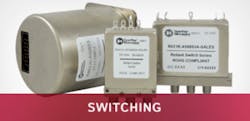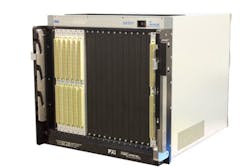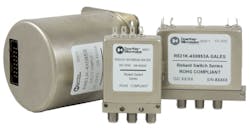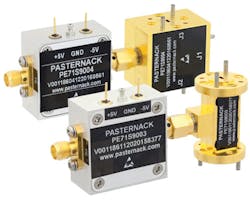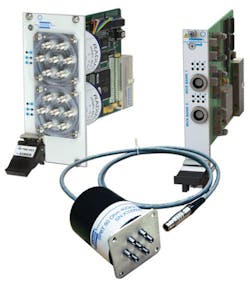Innovations span sensor emulation to microwave multiplexing
Switching technology innovation extends from systems and subsystems down to components—including reed relays, photorelays, and chips—with applications extending from sensor emulation to RF/microwave multiplexing. While test is a critical application for switching systems and components, manufacturers are also addressing applications ranging from intelligent factories to smart tunable antennas. Software has a role to play as well. Applicable markets extend from semiconductor manufacturing to military/aerospace system test.
Shaun Fuller, switching product manager at Pickering Interfaces, touted his company’s signal switching and programmable resistance simulation capabilities for test, with a unique aspect being the company’s breadth of product offerings. “The customers can buy what they need and not be forced into a product that is too oversized for the application or too short in terms of features,” he said. “For example, our PXI range of fault-insertion switches is by far the largest available in the industry, comprising 15 product families with 62 options in total. Our range of programmable resistance products (typically used for simulating remote sensors) comprises 130 options in PXI and 120 in PCI. Our philosophy has always been to offer optimal functionality, with the required level of performance, at the most competitive price—that is, offer the most efficient solution.”
Examples of the company’s offerings include PXI millivolt thermocouple simulator modules (Model 41-760), suitable for simulating the operation of a thermocouple. They are available in a choice of 8, 16, 24, or 32 channels—each channel providing a low-voltage output across two connector pins capable of providing ±20 mV with 0.7-µV resolution, ±50 mV with 1.7-µV resolution, and ±100 mV with 3.3-µV resolution, covering most thermocouple types.
In addition to a broad product offering, Pickering Interfaces serves a range of industry verticals, as indicated by its participation in a variety of recent tradeshows, including the International Microwave Symposium,1 SEMICON West,2 and AUTOTESTCON3 as well as the upcoming Automotive Testing Expo scheduled for October 24-26 in Novi, MI.
At Automotive Testing Expo, Fuller said, the company will exhibit its new Model 60-105 4-slot USB/LXI chassis (Figure 1). “This chassis compliments our recently released 2-slot USB/LXI modular chassis in that they both offer a small, lightweight form-factor ideal for portable, benchtop, and space-restrictive applications,” he said. The chassis are designed for desk or rack mounting and feature remote control via USB or LXI Ethernet, enabling a test system’s switching function to be located close to the target equipment. “This new 4-slot chassis supports between one and four Pickering 3U PXI modules,” Fuller added. “Possible systems include switching matrices up to 2,208 crosspoints or up to 72 channels of programmable resistor/sensor simulation.” (For more on what Pickering Interfaces and other companies will highlight at Automotive Testing Expo)
Courtesy of Pickering Interfaces
Switching subsystem
Marvin Test Solutions addresses switching with its GX7017 GENASYS subsystem (Figure 2), according to Mike Dewey, director of marketing. “The GENASYS GX7017 chassis is based on the 6U PXI standard and accommodates the innovative GENASYS switching architecture that combines high-density switching with maximum flexibility as well as our high-performance digital subsystem,” he said.
Courtesy of Marvin Test Solutions
He cited several key features of the GX7017, including support for up to nine GENASYS switching modules, offering over 2,200 multiplexed, hybrid test connections. “The GENASYS switching architecture offers an ‘any resource to any pin’ capability and uncompromising signal bandwidth performance, regardless of system configuration,” he said. It also offers support for up to eight GX5960 digital modules, enabling up to 256 digital channels to be routed via the GENASYS switch modules.
Another key feature, he said, is an integrated MAC Panel SCOUT mass-termination receiver providing a reliable, ”wireless” interface that eliminates thousands of wired connections. In addition, SwitchEasy integrated high-level switching software facilitates end-to-end signal routing. Finally, MTS has expanded the GENASYS switch-card portfolio with the introduction of the GX6864, a 500-MHz, 64 x 16 x 16 mux/matrix card, which supports 16 external and 16 internal analog bus resources.
GENASYS systems, Dewey said, “…are being deployed for production functional testing of high-value, mission-critical products in the MIL/aero market including satellites and airborne electronics. In particular, the GENASYS product line with its hybrid pin architecture is finding success with replacing legacy ATE systems as well as providing next-generation test capability for complex electronic assemblies at the module and system level.”
Coaxial switches
Dow-Key Microwave said it now offers the Reliant R461 (Figure 3), a 1 × 6 bidirectional coaxial switch for ATE applications. The new switch is part of the company’s Reliant Switch product series, which the company said encompasses 40 years of Dow-Key’s experience in the design and development of electromechanical RF switches with demanding specifications supporting challenging environments.
Courtesy of Dow-Key Microwave
The new coaxial switch features an operating frequency from DC to 26.5 GHz and offers isolation of 100 dB (up to 12.4 GHz) to maintain RF consistency for port-to-port testing. The switch can operate in break-before-make (cold-switching) or make-before-break (hot switching) applications and has a switching speed of 15 ms. Moreover, the Reliant R461JK version can sustain a guaranteed insertion-loss repeatability of 0.03 dB across the entire frequency band. It is offered with 50-Ω 2-W terminated ports, latching actuators, SMA connectors, and optical position indicators while providing an extended life cycle where each position can switch a minimum of 5 million cycles—a fivefold improvement from a typical multiposition switch, the company reports.
The switch can be controlled via a +24-VDC coil voltage. Other control options include using TTL or CAN bus logic. For more sophisticated control solutions, the CAN bus interface can be converted to Ethernet, GPIB, RS-232, or USB by adding an external Dow-Key-designed controller board.
Addressing millimeter-wave applications, Pasternack has launched a line of E and W-band PIN-diode waveguide switches (Figure 4). These SPST and DPDT switches are reflective designs that operate over an ultrabroadband frequency range with fast switching performance. They are suitable for telecommunications, test instrumentation, research and development, and radar front-end applications that may involve general switching, receiver protection, pulse modulation, or antenna beam switching.
Courtesy of Pasternack
The PIN diode waveguide switches consist of four models with fully integrated WR10 and WR12 waveguide ports covering E-band (60- to 90-GHz) and W-band (75- to 110-GHz) frequencies. The switch circuits integrate low-loss fin-line assemblies with high-performance GaAs beam-lead diodes—resulting in 4-dB typical insertion loss, greater than 25 dB of isolation, and switching times less than 300 ns. These waveguide PIN diode switches incorporate TTL driver circuitry with an SMA connector control port. All models require a dual voltage bias of ±5 VDC and have a maximum rated CW input power level of 0.5 dBm. Rugged MIL-grade compact package configurations combine both switch and control module packages and offer maximum performance and reliability over a temperature range of -55°C to +85°C.
Component-level switches
Companies developing switching components include Pickering Electronics, Pickering Interfaces’ sibling company, which debuted a new miniature reed relay with applicability to semiconductor test at SEMICON West in July. The Series 120 is a range of single-pole reed relays that require a board area of only 4 mm x 4 mm. Two switch types are available, a general purpose sputtered ruthenium switch rated for up to 20 W, 1 A, and a low-level sputtered ruthenium switch rated at 10 W, 0.5 A.
The company explained that the relay incorporates the same reed switches used in many other long-established Pickering Electronics products, but they are orientated vertically within the package, allowing very high density. The relays feature an internal mu-metal magnetic screen, which has the advantage of a high permeability and low magnetic remanence, eliminating problems that would otherwise occur due to magnetic interaction.
Toshiba America Electronic Components Inc. (TAEC) is also addressing semiconductor test and other applications by adding two mid-voltage products, the 100-V TLP3823 with a 3-A drive current and the 200-V TLP3825 with a 1.5-A drive current, to its lineup of large-current photorelays. The new products can replace mechanical relays in applications including industrial equipment, general-purpose inverters, HVAC, thermostats, and building-automation equipment as well as semiconductor testers. The new photorelays are housed in 8-pin DIPs and are available with both gull-wing (SMD) and wider creepage options.
The rate at which photorelays are being used to replace mechanical relays has accelerated in recent years, Toshiba said, adding that it is supporting this shift by applying its latest trench MOSFET process technology—8th generation UMOS—to enable output currents that exceed 1 A. Unlike mechanical relays, photorelays have no physical contacts subject to wear and tear.
Addressing intelligent-factory applications, Analog Devices Inc. has introduced a real-time Ethernet multiprotocol (REM) switch chip as part of its new generation of high performance, deterministic Ethernet connectivity solutions. The fido5000, developed by ADI’s Deterministic Ethernet Technology Group (formally Innovasic), reduces board size and power consumption while improving Ethernet performance at the node under any network load condition, the company said, adding that the chip is suited for synchronized, connected motion applications such as robotics. It attaches to ADI’s ADSP-SC58x, ADSP-2158x, and ADSP-CM40x motion-control processors, offering EtherCAT, PROFINET IRT, and POWERLINK connectivity. Cycle times below 125 μs are achievable, and the chip comes with drivers to simplify integration with any Industrial Ethernet protocol stack.
For Intelligent Factory applications, the fido5000 can be integrated with any processor, any protocol, and any stack, making it easy to incorporate a single industrial Ethernet interface that supports multiple protocols in any application. To support evolving Time Sensitive Networking standards, the fido5000 is “TSN-ready,” the company said.
And addressing wireless communications, Peregrine Semiconductor announced in June that Monarch Antenna Inc. is using UltraCMOS PE613010 tuning-control switches in Monarch’s latest prototype—a compact 4G tunable antenna. Monarch Antenna—a spinout of Delphi Automotive Systems—selected the PE613010 switch to showcase the “smart” switching capabilities of self-structuring antenna (SSA) technology in mobile handsets, the companies said, adding that initial prototypes show superior performance compared to existing antenna solutions.
“To fully demonstrate the advanced tuning capabilities of SSA technology, our team needed to find an SPST switch with low on-state resistance,” said Tayfun Ozdemir, Ph.D., co-founder and chief technology officer of Monarch Antenna, in a press release. “Our engineers had a long list of desired technical specifications, and Peregrine’s PE613010 was the only switch on the market that could meet our performance demands. Thanks to Peregrine’s RF switches, Monarch’s 4G tunable antenna demonstrates a clear advantage in antenna tunability and efficiency.”
‘Smart’ relay modules
In related news, in July Universal Switching Corp., a manufacturer of signal switching and distribution products, announced a new enhancement to its rugged DC to 800-MHz Series 7000 relay-module product line. The new Series E7000 “smart” relay modules offer an efficient way to power and control the relay via a new 10/100 Ethernet port integrated directly on the module. The port also includes PoE (Power over Ethernet) capability. Company engineers stated in a press release, “This new capability allows a relay to be situated anywhere as long as it can be plugged into a network connection. Once it is connected to a network with PoE capacity, the relay can be controlled via a standard web browser, and virtually from anywhere via the Internet.”
The relays are offered with a number of options including signal connector types (BNC, SMA, TNC, and Triax), the number of ports (1 x 2 to 1 x 24), and switch functions (normally open or self-terminating type). The Series E7000 module family is a rugged design suited for many uses in many markets (including test and measurement, communications, and mobile-van applications).
USC also in July announced the 5.0 release of its RouteWarePRO control and monitor software package. The company says the new 5.0 release offers features such as auto discovery, scheduling, and on-the-fly channel naming. It is specifically designed for Windows 10/8/7 compatibility to control and monitor virtually all USC products. The company reports that during field trials, factory application staff demonstrated that the software was simple to install and quickly connected to USC hardware. Available for immediate download at the company website, the software includes free 30-day trial and free technical support.
Pickering Interfaces also addresses software. Providing input for an article earlier this year on PXI,4 Bob Stasonis, director of sales and marketing, said, “We recognize that in a modular test market, we need to work with all major programming environments. So our drivers are written to support programming languages like LabVIEW and C++. In addition, because switching requirements have gotten more and more complex, we created Switch Path Manager,5 which makes complex switch routing requirements easier to address and helps speed time to market for test systems.”
The latest products that work with Switch Path Manager are new 50-GHz additions to the company’s 40-785B PXI microwave multiplexer lineup (Figure 5). These new modules are single or dual 6-channel multiplexers with relays mounted on the front panel. They are suitable for switching 50-Ω signals up to 50 GHz. The single-slot version can support up to three remotely mounted multiplexers. All options include LEDs to indicate channel setting, a feature supported in earlier rack and stack solutions.
Courtesy of Pickering Interfaces
The 40-785B microwave multiplexer range is compatible with any PXI chassis and can be fitted to PXI hybrid slots in a PXIe chassis. It can also be used in Pickering’s Ethernet-controlled LXI modular chassis with a choice of 18 and seven slots, as well as the 2-slot USB/LXI chassis for remote mount relay requirements.
References
- Earls, Alan, “WLAN, radar, IoT, V2X to complement 5G at IMS,” EE-Evaluation Engineering, June 2017, p. 8.
- Nelson, Rick, “SEMICON West addresses extended supply chain,” EE-Evaluation Engineering, September 2017, p. 26.
- Earls, Alan, “MIL/aero sector prepares for growth amidst currents of change,” EE-Evaluation Engineering, September 2017, p. 6.
- Earls, Alan, “20-year PXI development has seen continued growth,” EE-Evaluation Engineering, May 2017, p. 6.
- von Bassenheim, Matthias, “Switching and routing software—what are the benefits?” EE-Evaluation Engineering, December 2016, p. 22.
For more information:
About the Author

Rick Nelson
Contributing Editor
Rick is currently Contributing Technical Editor. He was Executive Editor for EE in 2011-2018. Previously he served on several publications, including EDN and Vision Systems Design, and has received awards for signed editorials from the American Society of Business Publication Editors. He began as a design engineer at General Electric and Litton Industries and earned a BSEE degree from Penn State.
